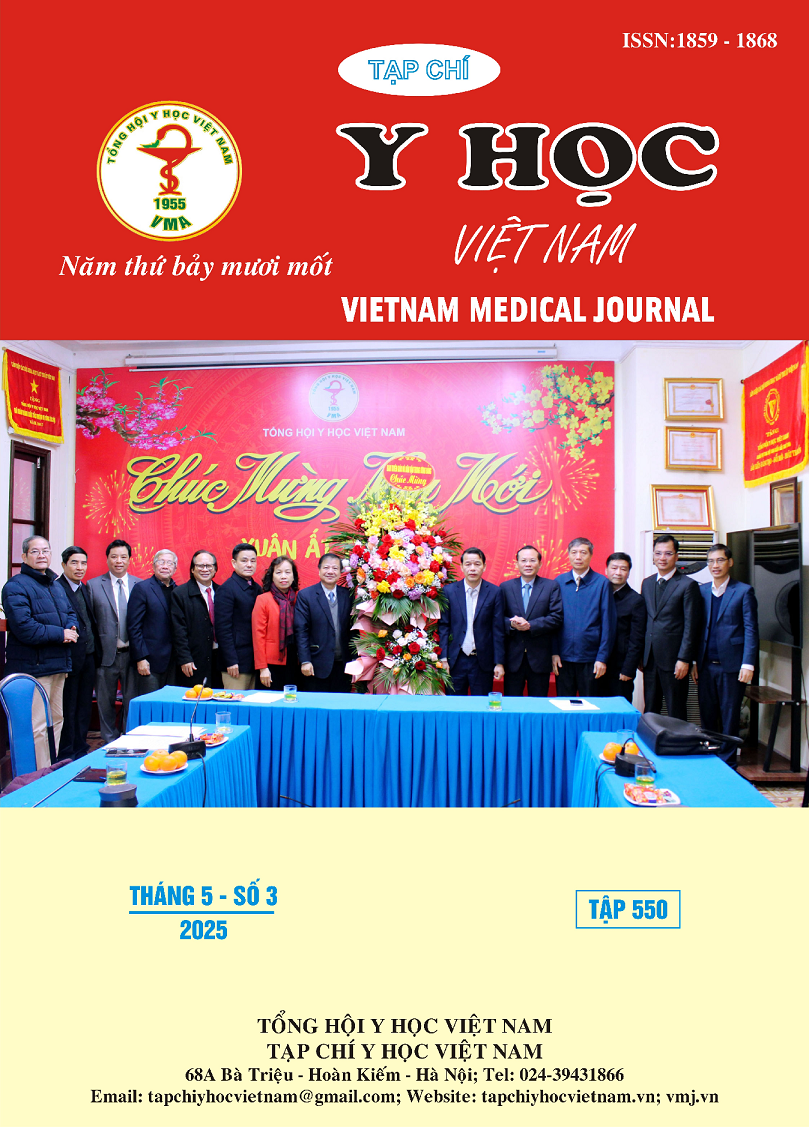COMPARISON OF CLINICAL AND LABORATORY CHARACTERISTICS IN PATIENTS WITH NON-ST-ELEVATION MYOCARDIAL INFARCTION WITH AND WITHOUT LEFT VENTRICULAR SYSTOLIC DYSFUNCTION
Main Article Content
Abstract
Introduction: Non-ST-elevation myocardial infarction (NSTEMI) is a critical cardiovascular condition with diverse clinical and laboratory characteristics. Left ventricular ejection fraction (LVEF) plays a key prognostic role, especially in patients with left ventricular systolic dysfunction (LVSD). This study aims to describe the clinical and laboratory features of NSTEMI patients and compare those with and without LVSD, contributing to optimizing treatment strategies. Objective: This study aims to describe the clinical and laboratory characteristics of patients with non-ST-elevation myocardial infarction (NSTEMI) and compare those with and without left ventricular systolic dysfunction (LVSD). Subjects: All patients with a first diagnosis of NSTEMI, who were treated at Cho Ray Hospital from February 2024 to April 2024. Study design: A descriptive, cross-sectional, prospective study. Results: During the study period, 117 patients with NSTEMI were included in the analysis. The mean age was 65.5 ± 11.1 years, with a male predominance (62.4%) and nearly half being overweight or obese (49.6%). Most patients had at least one atherosclerotic cardiovascular risk factor (94.9%), with hypertension being the most common (76.9%). The majority were admitted with Killip I (83.8%), while only a small proportion had Killip II (14.5%), Killip III (1.7%), and none had Killip IV. Regarding laboratory findings, most patients had dyslipidemia, characterized by low HDL-C and elevated LDL-C above treatment targets. On admission ECG, 32.5% had normal findings, 67.5% had ST depression or T-wave inversion, and 6.8% had atrial fibrillation. Coronary angiography revealed that 46.2% had triple-vessel disease, and 76.1% had multivessel involvement. The prevalence of left ventricular systolic dysfunction (LVSD, LVEF < 50%) was 46.1%. Patients with LVSD had higher heart rates (82 vs. 77.2 bpm, p = 0.033), a greater proportion with Killip ≥ II (29.6% vs. 4.8%, p < 0.001), higher hs-cTnI levels (15,314.8 vs. 3,277.8 pg/mL, p < 0.001), higher CK-MB (73.5 vs. 41.9 U/L, p = 0.003), and longer hospital stays (5.5 vs. 5 days, p = 0.042). There were no statistically significant differences between the two groups in demographic characteristics, cardiovascular risk factors, coronary artery characteristics, or other biochemical parameters (p > 0.05). Conclusion: NSTEMI patients with LVSD exhibit more severe clinical presentation, greater myocardial injury, and a longer hospital stay compared to those without LVSD.
Article Details
Keywords
Non-ST elevation myocardial infarction, Left ventricular systolic dysfunction, Killip classification, Troponin, Coronary angiogram
References
2. Carias M, Paralta De Figueiredo M, Picarra B, et al. In patients with acute coronary syndromes, left ventricular dysfunction is associated with an increased risk of cardiac arrest. European Journal of Preventive Cardiology. 2023;30(Supplement_1):zwad125.056. doi:10.1093/eurjpc/zwad125.056
3. Miller AL, Dib C, Li L, et al. Left Ventricular Ejection Fraction Assessment Among Patients With Acute Myocardial Infarction and Its Association With Hospital Quality of Care and Evidence-Based Therapy Use. Circ: Cardiovascular Quality and Outcomes. 2012;5(5):662-671. doi:10.1161/CIRCOUTCOMES.112.965012
4. Lang RM, Badano LP, Mor-Avi V, et al. Recommendations for cardiac chamber quantification by echocardiography in adults: an update from the American Society of Echocardiography and the European Association of Cardiovascular Imaging. J Am Soc Echocardiogr. 2015;28(1):1-39.e14. doi:10.1016/ j.echo.2014.10.003
5. Nguyen TH, Nguyen TBY. Đặc điểm và giá trị tiên lượng của dấu hiệu ST chênh xuống ở bệnh nhân nhồi máu cơ tim không ST chênh lên. Tạp chí Tim mạch học Việt Nam. March 4, 2023:58-66.
6. Li L, Zhou X, Jin Z, et al. Clinical characteristics and in-hospital management strategies in patients with acute coronary syndrome: results from 2,096 accredited Chest Pain Centers in China from 2016 to 2021. Cardiology Plus. 2022;7(4):192-199. doi:10.1097/CP9.0000000000000032
7. Kim YH, Her AY, Jeong MH, et al. ST-elevation versus non-ST-elevation myocardial infarction after combined use of statin with renin–angiotensin system inhibitor: Data from the Korea Acute Myocardial Infarction Registry. Cardiol J. 2022;29(4):647-659. doi:10.5603/CJ.a2021.0007
8. Patidar N, Kumar K, Gupta BB, Jha RK. Study of lipid profile of patient with acute myocardial infarction. IJAR. 2022;10(12):1374-1380. doi:10. 21474/IJAR01/15979.


